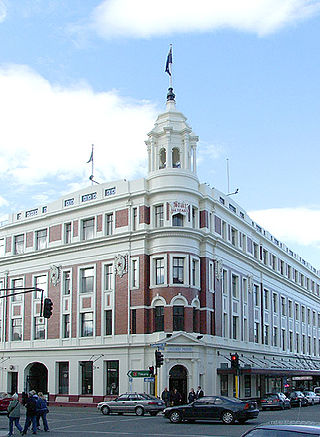
Cromwell is a town in Central Otago region of the South Island of New Zealand. Cromwell is located on the shores of Lake Dunstan where the Kawarau river joins Lake Dunstan. Cromwell was established during the Otago gold rush and is now more known as one of the sub regions of the Central Otago wine region. In 2018, the town of Cromwell was home to a population of 5610 people.

The Otago Daily Times (ODT) is a newspaper published by Allied Press Ltd in Dunedin, New Zealand. The ODT is one of the country's four main daily newspapers, serving the southern South Island with a circulation of around 26,000 and a combined print and digital annual audience of 304,000. Founded in 1861 it is New Zealand's oldest surviving daily newspaper – Christchurch's The Press, six months older, was a weekly paper until March 1863.

Lawrence is a small town in Otago, in New Zealand's South Island. It is located on State Highway 8, the main route from Dunedin to the inland towns of Queenstown and Alexandra. It lies 35 kilometres to the northwest of Milton, 11 kilometres northwest of Waitahuna, and close to the Tuapeka River, a tributary of the Clutha.

Thomas Gabriel Read was a gold prospector and farmer. His discovery of gold in Gabriel's Gully triggered the first major gold rush in New Zealand.

The Otago Gold Rush was a gold rush that occurred during the 1860s in Central Otago, New Zealand. This was the country's biggest gold strike, and led to a rapid influx of foreign miners to the area – many of them veterans of other hunts for the precious metal in California and Victoria, Australia.

Sir George Fenwick was a New Zealand newspaper proprietor and editor. He is best known for his time as manager and editor of the Otago Daily Times, during which time he supported the campaign initiated by Rutherford Waddell against sweat shops.
The Kalgoorlie Miner is a daily newspaper circulating in the City of Kalgoorlie-Boulder and the Goldfields-Esperance region, in Western Australia.
The following lists events that happened during 1861 in New Zealand.
Tuapeka is a former parliamentary electorate in the Otago region of New Zealand, from 1871 to 1911.
The Star is a free newspaper published weekly in Dunedin, New Zealand by Allied Press since 1979. It is the successor to The Evening Star, which was the city's daily evening newspaper from June 1863 to 1979.

Thomas Alfred Sneyd Kynnersley, who signed as T. A. Sneyd Kynnersley, was a 19th-century Member of Parliament from the West Coast, New Zealand.
The Otago Witness was a prominent illustrated weekly newspaper in the early years of the European settlement of New Zealand, produced in Dunedin, the provincial capital of Otago. Published weekly, it existed from 1851 to 1932. The introduction of the Otago Daily Times, followed by other daily newspapers in its circulation area, led it to focus on serving a rural readership in the lower South Island, where poor road access prevented newspapers being delivered daily. It also provided an outlet for local fiction writers. It is notable as the first newspaper to use illustrations and photographs and was the first New Zealand newspaper to provide a correspondence column for children, which was known as "Dot's Little Folk". Together with the Auckland-based Weekly News and the Wellington-based New Zealand Free Lance it was one of the most significant illustrated weekly New Zealand newspapers in the 19th and early 20th centuries.

During the Australian gold rushes, starting in 1851, significant numbers of workers moved from elsewhere in Australia and overseas to where gold had been discovered. Gold had been found several times before, but the colonial government of New South Wales had suppressed the news out of the fear that it would reduce the workforce and destabilise the economy.

Choie Sew Hoy also known as Charles Sew Hoy was a notable New Zealand merchant, Chinese leader, gold-dredger and a New Zealand Business Hall of Fame laureate. He was born in the village of Sha Kong in the Poon Yu District of Guangdong Province, China in about 1838.

The Connecticut Valley Railroad was a railroad in the state of Connecticut founded in 1868. The company built a line along the Connecticut River between Hartford and Old Saybrook, which opened in 1871. It was reorganized as the Hartford and Connecticut Valley Railroad in 1880, and leased by the New York, New Haven and Hartford Railroad in 1887. Following partial abandonments by the New Haven Railroad and successor Penn Central Transportation Company between 1968 and 1972, the line south of Middletown was revived as the Valley Railroad, a heritage railroad, while the portion in Middletown and northward saw operation by several freight railroads. As of 2022, the Providence and Worcester Railroad and Connecticut Southern Railroad both operate portions of the former Connecticut Valley Railroad.

The Southern Argus is a newspaper first published from March 1866 in Port Elliot, South Australia, and then in Strathalbyn from 1868 to the present. It is published on Thursdays.
The 1898 Tuapeka by-election was a by-election held on 2 November 1898 during the 13th New Zealand Parliament in the rural lower South Island electorate of Tuapeka.
The New Zealand Times was a New Zealand daily newspaper published in Wellington from 1874 to 1927.
The Ensign is a regional newspaper based in Gore, New Zealand published on Wednesdays and Fridays by Allied Press Ltd. It was first published in 1878 as The Mataura Ensign and changed to its current name in 1973. The newspaper features coverage of local government, sports and recreation, arts and entertainment, education, farming and business news. It is currently distributed to approximately 12,000 homes over a circulation area that includes Gore and the surrounding area that stretches from Mandeville and Waikaka in the north to Mataura in the south.












